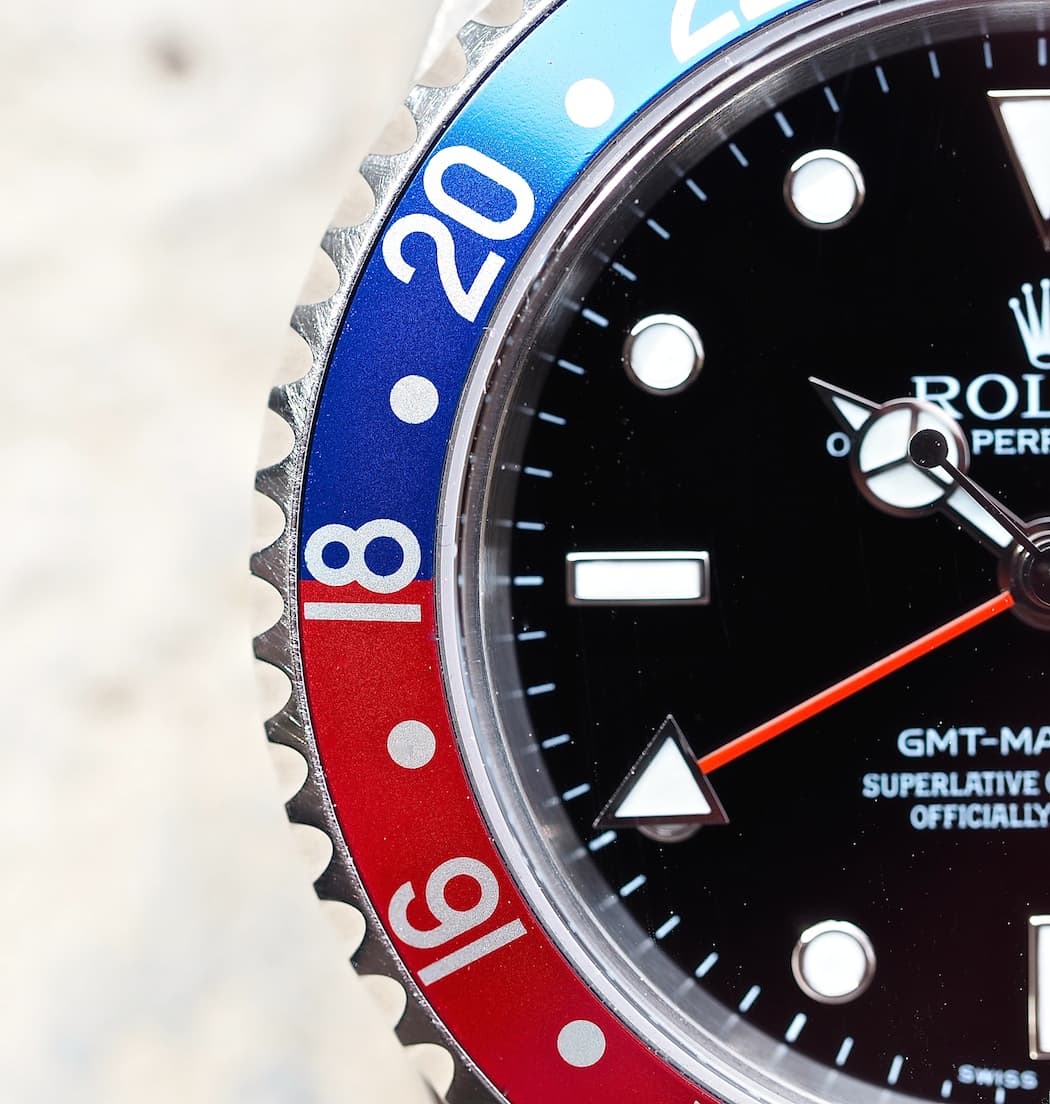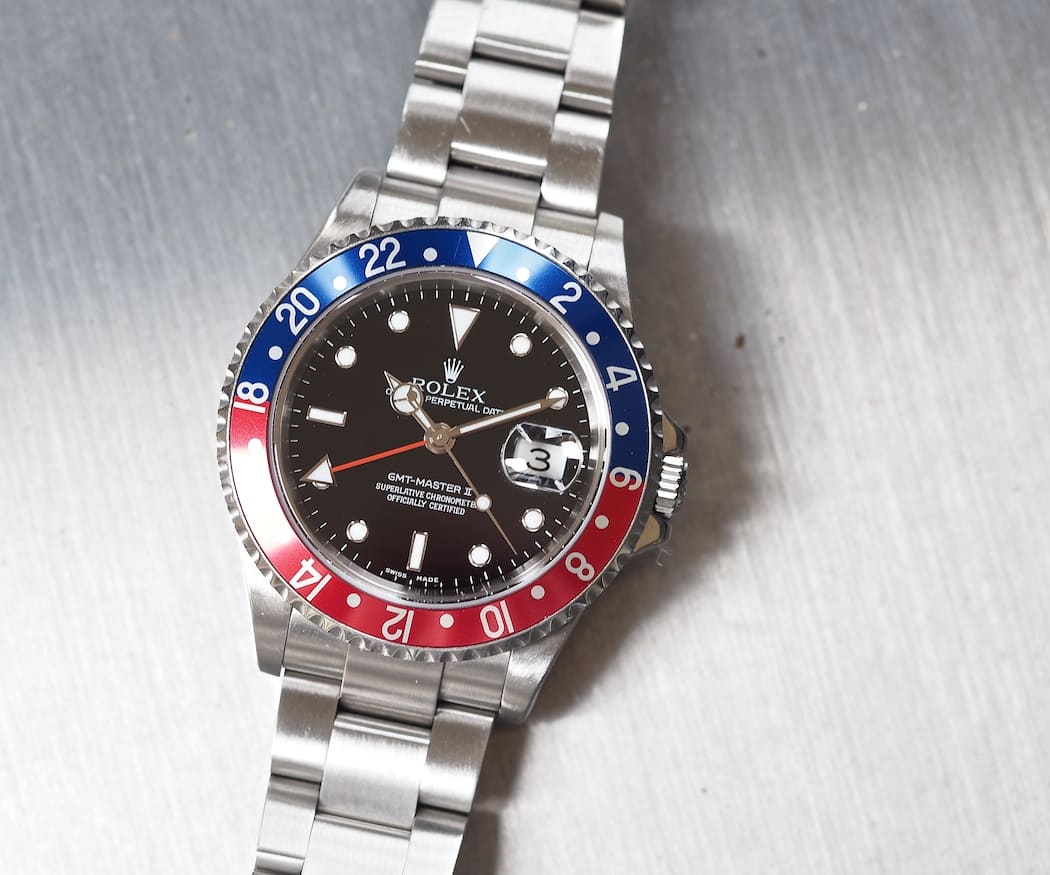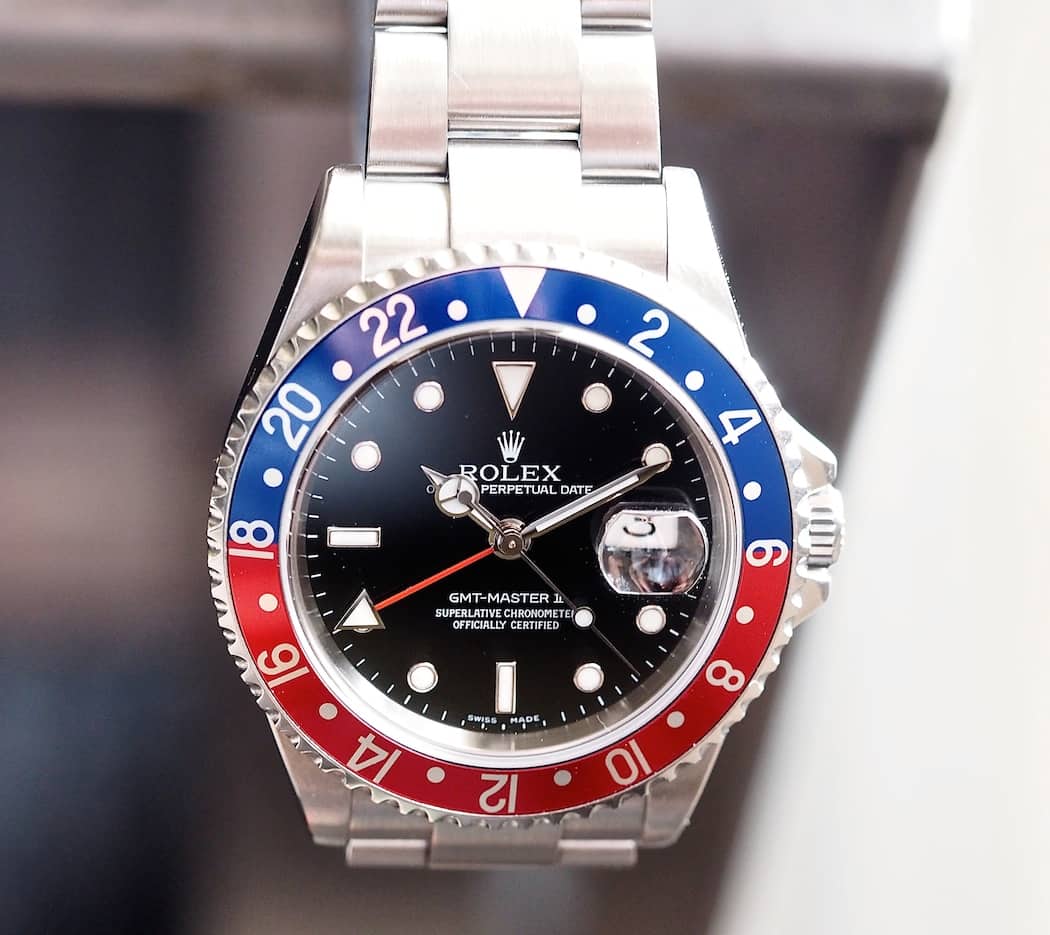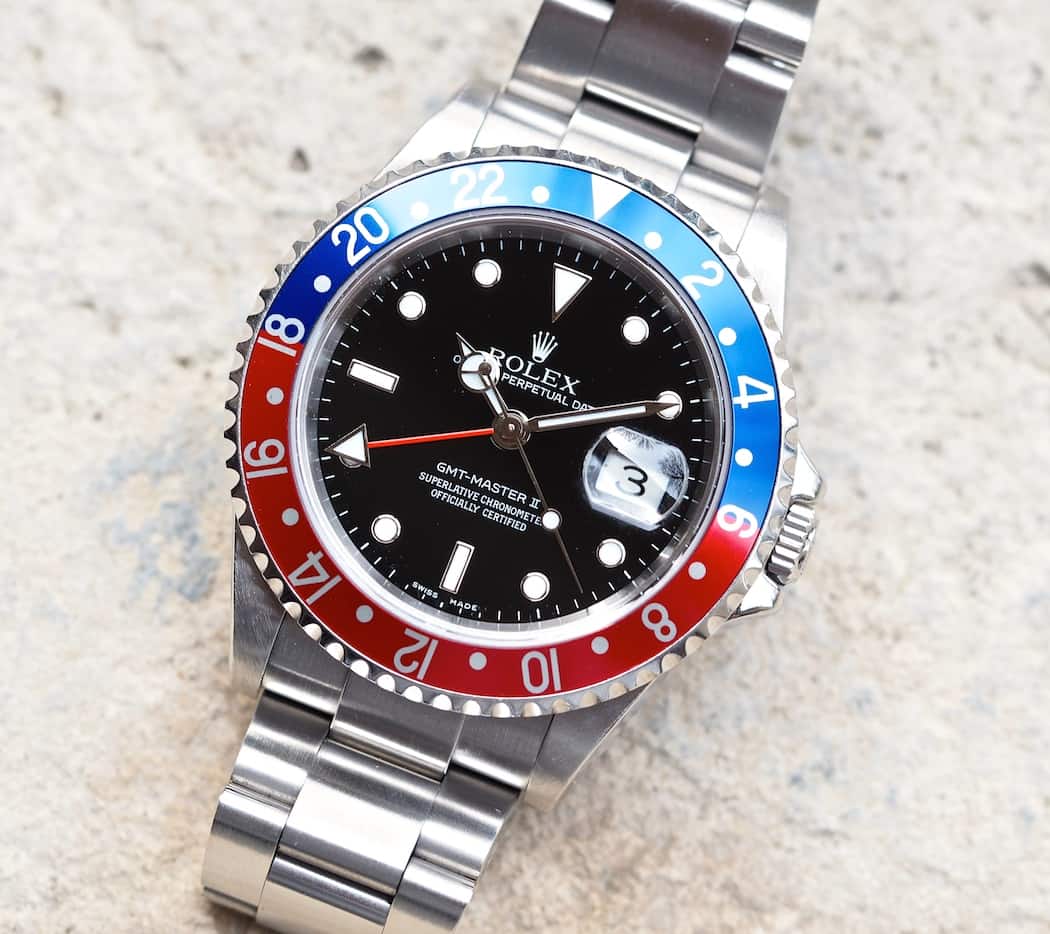#TBT – Rolex GMT-Master II 16710
I suppose that I could be faulted for featuring the rather newish Rolex GMT-Master II 16710 in a #TBT article, but I’ll live with it.
I’ve covered a couple newer pieces in this series such as the Rolex Explorer 14270 and, more recently, the IWC Mark XII, so I’m more on the side of featuring what I’d call classics instead of purely vintage. Definitions aside, the Rolex 16710 is definitely a classic and one that continues to be on the acquisition list of many people; let’s find out why.
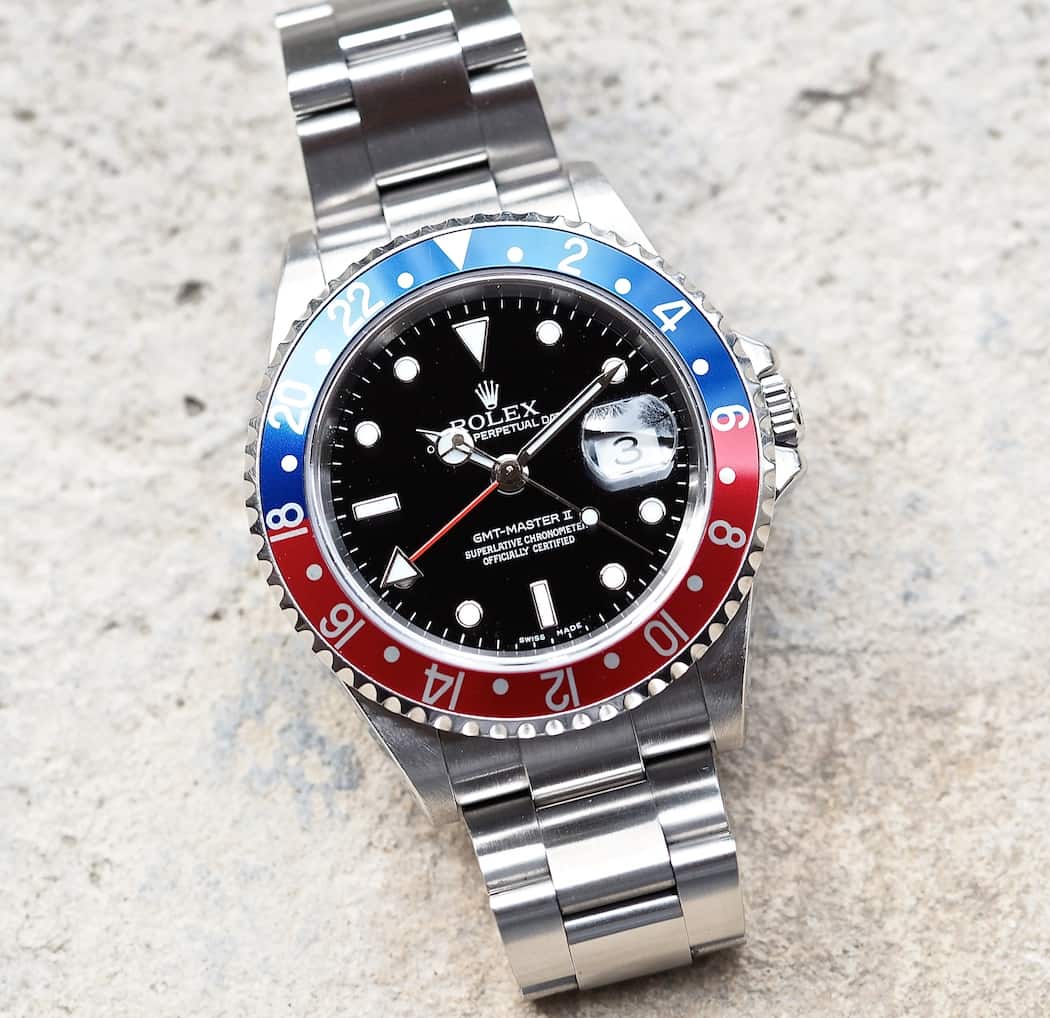
The Rolex GMT-Master II 16710 was around for so long – nearly 20 years – that it’s still hard to believe it’s gone
The Rolex GMT-Master II 16710
It’s awfully hard to believe that the Rolex GMT-Master II 16710 has been gone from showrooms since roughly 2007. That’s nine years ago! It’s hard to believe because the 16710, itself, debuted all the way back in 1989 and seemed like one of those omnipresent pieces – especially when it came to buying a piece like the one before you with a so-called “Pepsi” bezel. If my research is correct, Rolex made a Pepsi-bezeled watch in either GMT-Master or GMT-Master II form from the inception date of the line in 1954 through 2007 and then, poof, they stopped. Today, as we all know, Rolex is back with a Pepsi-bezeled GMT-II but it’s only for the extremely well heeled because it’s offered solely in an uber-pricey white gold case. Look, it’s not as if Rolex hurt for business while not serving up a Pepsi – in fact, when the 116710 debuted with only a black bezel in 2008, people were on waiting lists – but it’s odd when a famed company decides to kill off its golden goose. Blame ceramics technology I suppose.
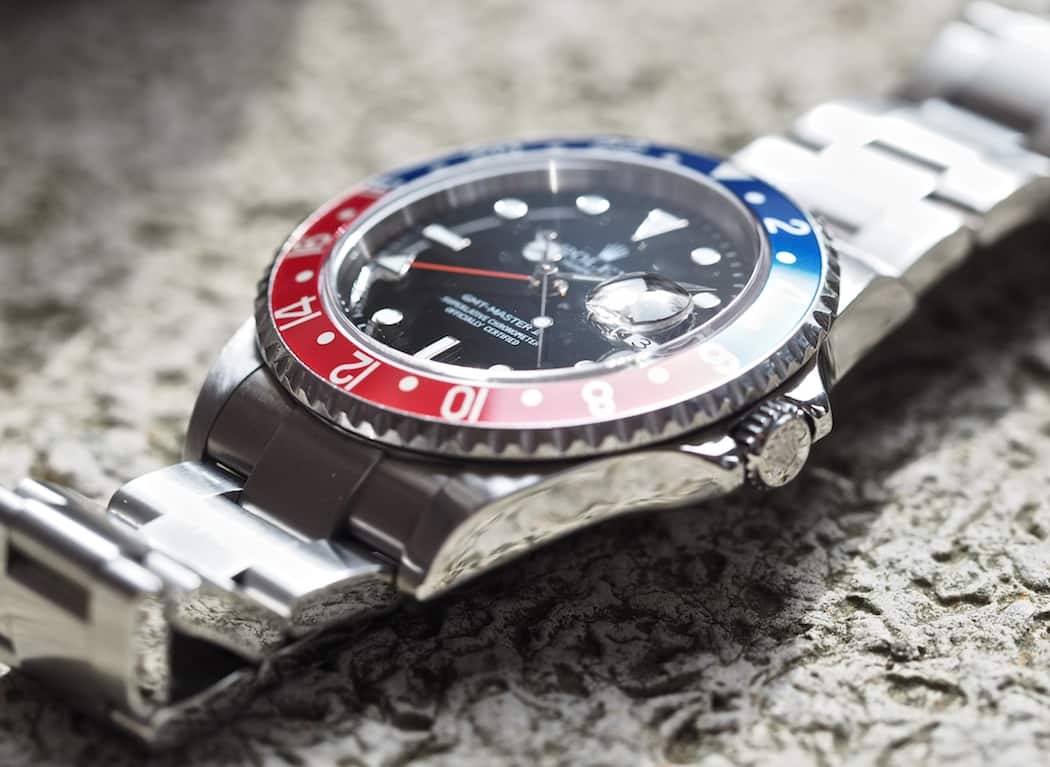
The Rolex 16710 GMT-Master II features Solid End Links in a nod to modernity, but still has nice slim lugs and a smaller crown
The Rolex 16710 is a future classic
Aside from the long lifecycle of the Rolex GMT-Master II 16710 giving some sort of credence to the watch as a future classic, I have other reasons as well. First and foremost, much like the aforementioned Explorer 14270, the 16710 is part of what I consider as the last of the old line from Rolex. These watches weren’t in any way inexpensive, so don’t confuse me when I say they were comparatively reasonable by today’s standards, but, in fact, they were. Furthermore, the 16710’s, along with the Submariners, Sea Dwellers, Explorers, Explorer II’s, and even the Daytona’s used trademark old-school Rolex cues like rattling bracelets, clasps, smaller indices/hands and featured slim lugs and small crowns where appropriate. I don’t mean to decry Rolex’s current offerings – I actually think that with the newly announced Explorer that they’re headed back on track – but I’ve always said that I miss the more pure and, dare I say, rough and tumble look of the old pieces. Pieces like the 16710 looked like the type of watches you’d actually swim with or not think twice about when rummaging through your toolbox and I get the feeling that today’s GMT-II is treated much differently. Credit pricing or a whole lot more polish for making today’s watches less sacrificial, but I guess it just makes me sentimental.
Two physical traits stand out to make the Rolex GMT-Master II 16710 a real standout as well. With the GMT, it’s really all about the bezel. Historically, this blue and red bezel was developed for use by Pan-Am pilots starting in 1954 and was even issued as standard equipment. It was such a popular design that other companies followed suit such as Zodiac, Heuer, Seiko, and Wittnauer – to name but a few. Originally crafted in brittle bakelite, the bi-colored bezel soon gave way to becoming an aluminum inlay and it stayed this way until the model’s demise in 2007. It’s this bezel, in bright or faded form, that’s so damn attractive. I’m all for new materials such as the Cerachrom that Rolex uses today for its bezels, but owning an aluminum bezeled Rolex and having it age along with you is one of those rites of watch ownership that everyone should experience. And by the way, at various times, the GMT or GMT-II was offered with a Pepsi, Coke (black and red), or black aluminum inlay on the stainless models – all are fantastic. The other characteristic I enjoy about the 16710 is its matte bracelet. Nothing riles me more than a Rolex sports watch with polished center links – maybe I can excuse it on Daytona, but the GMT, to me, belongs with brushed centers. A matte finish simply adds to the tough look of the watch and stems back to the introduction of the watch. On this specific model, because it’s a later version, it has the lovely Oysterlock 78790 (much smaller clasp than on a Sub, by the way) with solid end links (SEL’s).
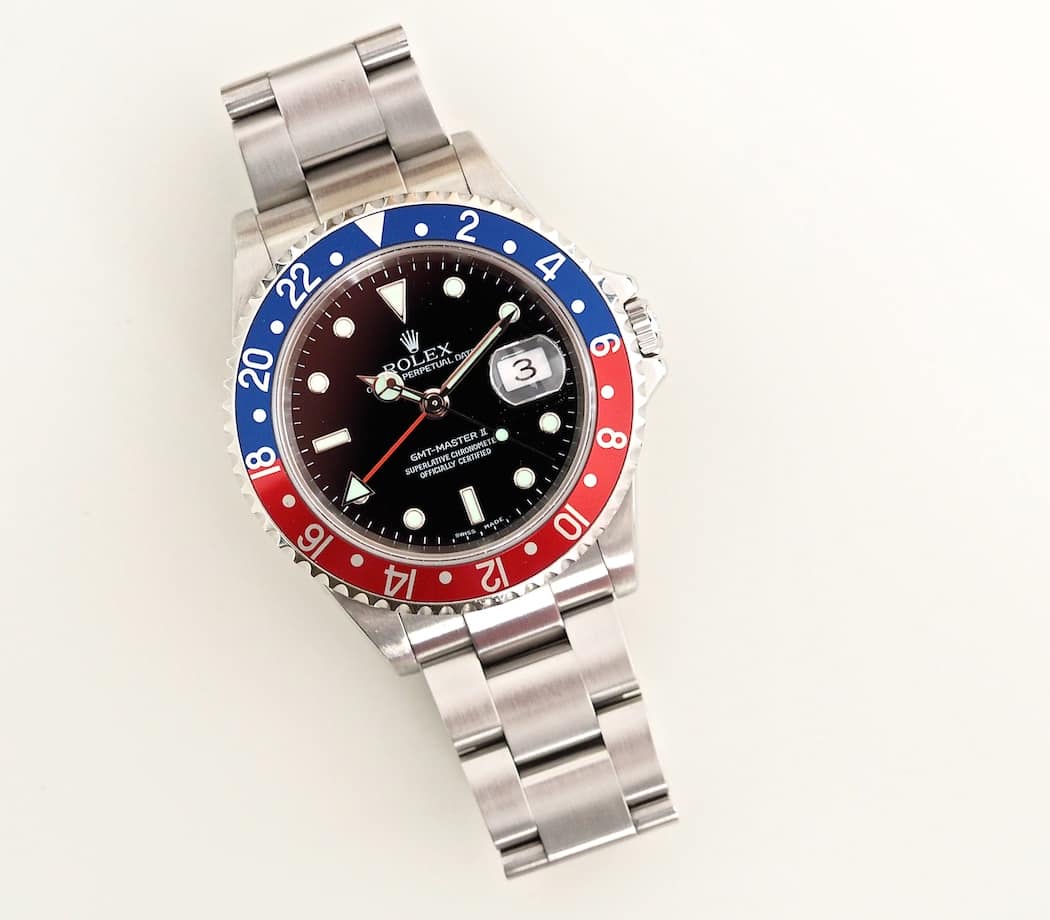
The Rolex 16710 GMT-Master II is purposeful – it blends a surprising amount of details into a very legible package
There’s just something about that bezel…
I didn’t grow up seeing too many GMT’s in South Florida. No, per my article on the 14060M, it was clearly Submariner territory. I blame wanting a Rolex GMT-Master II 16710 on the fact that it was around for so long that it grew on me and when I really got around to realizing that the Pepsi was gone for good and any replacement would likely look a whole lot different, I wanted one. Plus, I had moved to Europe and found GMT’s to be everywhere – especially in Italy where brighter colors seem to be appreciated. I got hooked on seeing faded Pepsi’s and Coke’s dangling off the wrists of sun-tanned Mediterranean’s – yep, I wanted one. I knew I wanted a newer Pepsi and it actually took me several months to find a good one with all of its papers, etc. I finally did, via chrono24, drove to pick it up during 2012, and you can see the result.
The Rolex GMT-Master II 16710 before you is an F-series (mid-2003/2004) and the person who sold it to me sparingly wore it – he was about to buy a Deepsea Sea- Dweller. I believe he was the second owner because he bought it in 2009 and the watch was originally sold in 2006. As you can see, the watch is in beautiful condition and the bezel really pops! The blue and red are absolutely gorgeous and unbeknownst to me, the surface of the inlay is actually not glossy. This actually contrasts nicely with the inky black gloss dial with its white gold applied indices. About those indices – they’re really sized well in my opinion. There’s nothing too large or too small on this dial including the hands. I’m normally not even a fan of the Cyclops but I even find that to simply be a part of the design that I expect.
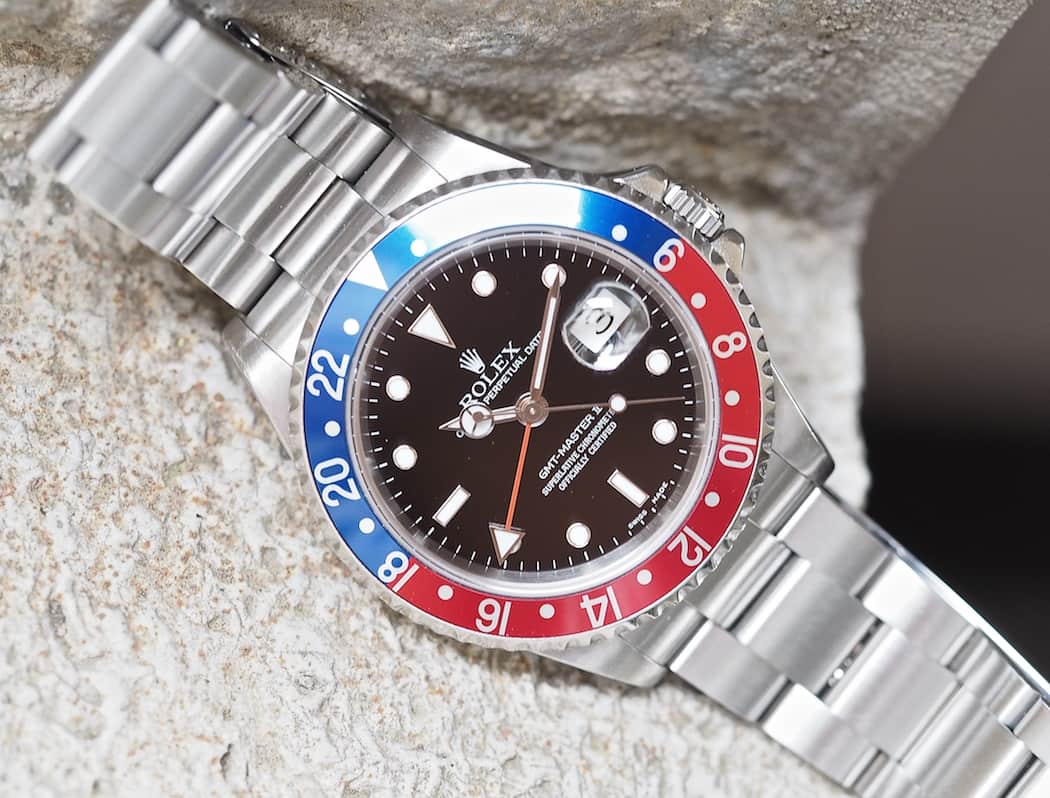
The Rolex GMT-Master II 16710 is a great all-around watch – it serves well as the only piece to bring with you on a trip – from the beach to the boardroom
The 16710 is wearable and versatile
Another word about size comes into play when talking about the case of the Rolex GMT-Master II 16710 and that’s “lightweight”. Of course, it’s not truly a featherweight, but for a watch that looks a lot like a Submariner, it’s much more svelte. The case thickness, crystal thickness and things like the crown and crown guards are all more diminutive. This was a real surprise for me and at first, it almost felt like something was wrong, but I quickly grew to appreciate it from a comfort perspective – especially when you’re jet-lagged and everything feels heavy – and for fitting under dress shirts. That leads me to a couple more points – wearability and travel. First off, the 16710 is like a Submariner, that rare tool watch that can be worn with anything. I wear mine swimming (100m of water resistance is there plus a twinlock crown) and then right into the office the next day. Sure, blue and red might seem to clash with your suit, but it won’t – in fact, it’s a good-looking accent!
Regarding travel, the Rolex GMT-Master II 16710 was absolutely built for the purpose. I spend a lot of time on planes and I find GMT-style watches very helpful. From my Seiko Astron to my recently acquired Enicar Sherpa Super Jet, I enjoy them a lot and the utility is really there. Honestly, as many times as I’ve flown to Asia or the Americas, one’s Outlook calendar doesn’t always adjust correctly, but my watches run true. I have an old Rolex GMT 1675 and I really had no idea that the GMT hand – that red hand with arrow – was not able to be set independently. No, instead, much like on the Enicar, one sets the time and the arrow travels around at half speed and you simply twist the bezel to show a time zone at home or wherever else you’re tracking.
Using the 16710…
With the GMT-II, however, you don’t get to adjust the red hand independently, but you do get to “quick set” the hour hand. This is helpful because you can basically move the hour hand at a slow pace in order to move the red GMT hand to where you’d like it (likely keeping the bezel with the arrow at 12:00) and then adjust the hour hand using the quick set to adjust the date and hour. Of course, if you’re in a rush, you can simply set the time and date (again, date is only set by using the quick set hour hand to race around the dial), let the red hand fall where it may, and adjust the bezel. Note that the bezel has some seriously nice ratcheting action and is bi-directional. The movement doing the job is the chronometer-rated 3185, which beats at 28,800 bph. When Rolex introduced this movement, it replaced a similar performing 3085 movement (found in the “Fat Lady”) but lost a lot of thickness. The very last batch of reference 16710 GMT-Master II watches had the updated caliber 3186 movement, with Parachrom hairspring. Do note that up until 1999, Rolex sold a GMT-Master alongside the GMT-II. It was a lower cost model that had a quick set date but independent GMT hand – meaning the bezel was necessary for showing a second time zone. It’s hard to believe that two GMT’s were available at one point when looking at today’s somewhat slimmed-down Rolex lineup!
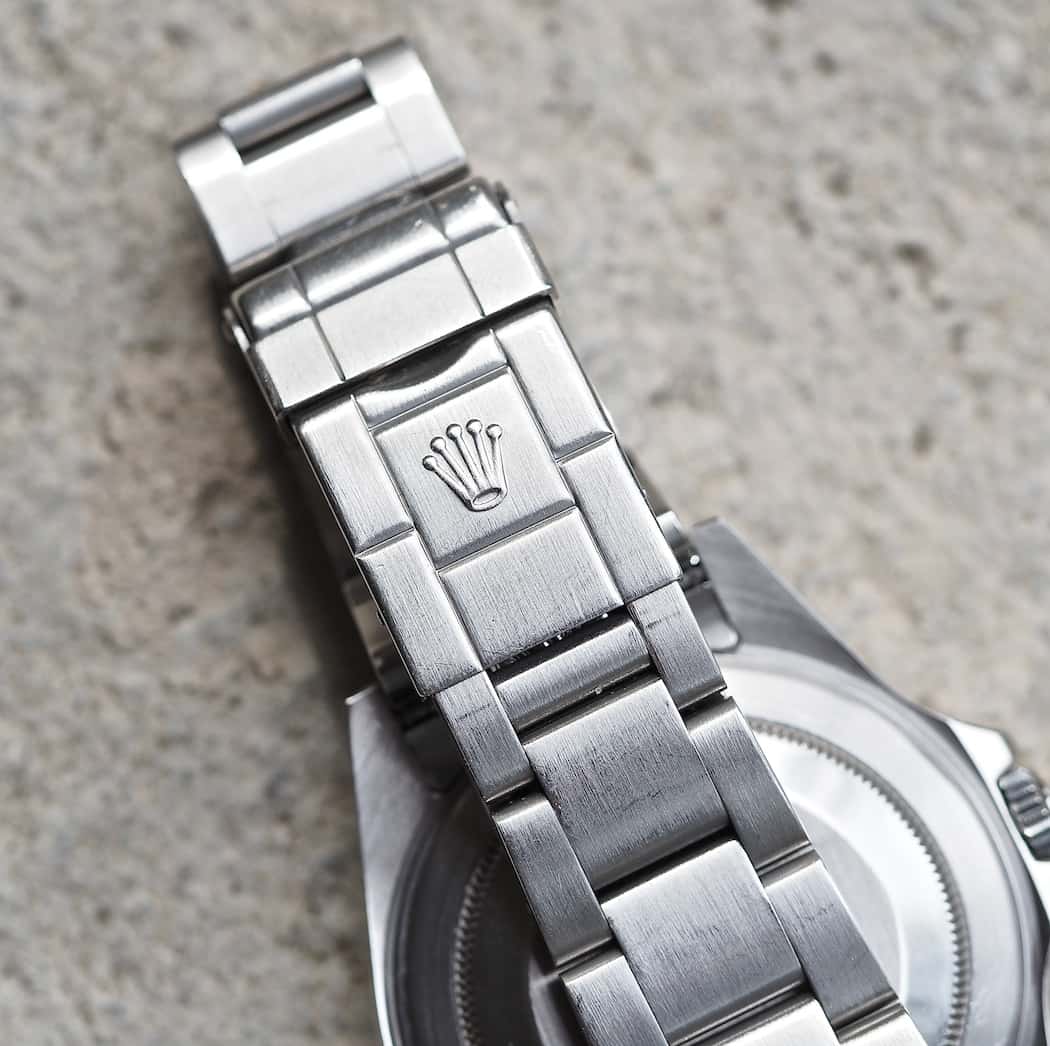
The Rolex 16710 GMT-Master II Fliplock bracelet – much slimmer than on the Sub and without a wetsuit extension
As this Rolex GMT-Master II 16710 is from 2004, it already has Super Luminova and that continues to shine brightly. Earlier models had Luminova or even Tritium. Prior 16710’s even had stamped end links and drilled lugholes – a lovely trait. I’d invite you to head to this fantastically clear site to read about the differences that occurred over the model’s life. From bracelet options to dial variants – it’s all there.
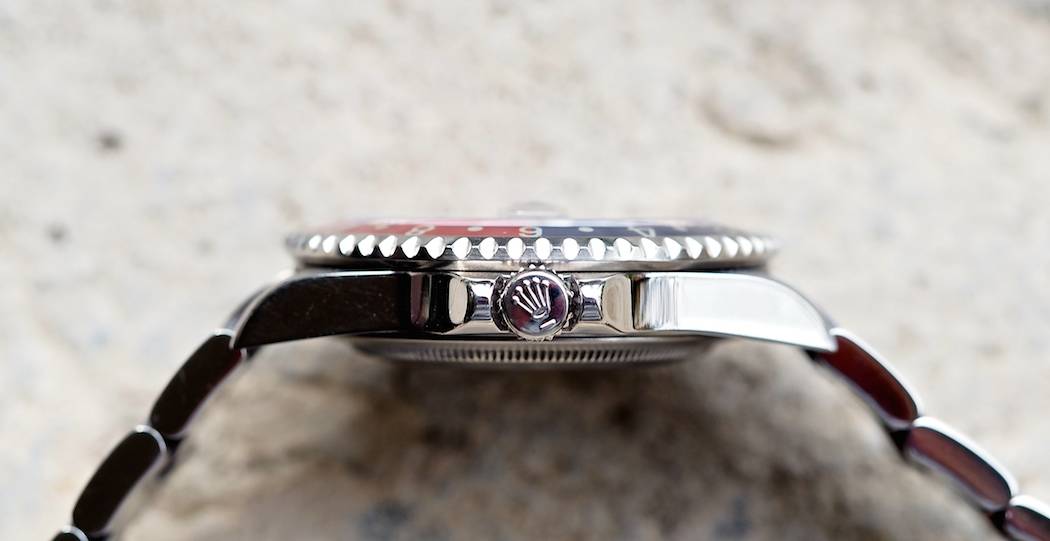
The Rolex GMT-Master II looks like a Sub head-on, but it’s actually quite slim and fits under a shirt nicely
Finding your Rolex GMT-Master II 16710
Of course, no one knows the production totals of the Rolex GMT-Master II 16710, but this was a very popular model. From a collectability standpoint, I don’t think we’re looking at the next manual wind Daytona, but as I mentioned, as the last of the breed, these 16710’s are very popular. They’re modern watches with all the reliability you’d expect but with a decent dose of old-style charm. Bezel switching seems to occur and I’ve not really found a good way to prove what a watch originally came with or not – bezel inlays have codes (BLRO is the Pepsi), but I don’t see this marked on the papers from Rolex. Still, it seems that Pepsi’s tend to be the most popular of the trio. Prices for 16710’s are surprisingly expensive and with price increases happening at least annually on 116710’s, I often find that predecessor Rolex’s trend upward as well. Budget anywhere from $5,000 – 7,000 for a nice piece depending on condition model year and whether all the boxes and papers are included. Pieces are definitely out there, but well-priced examples move swiftly.
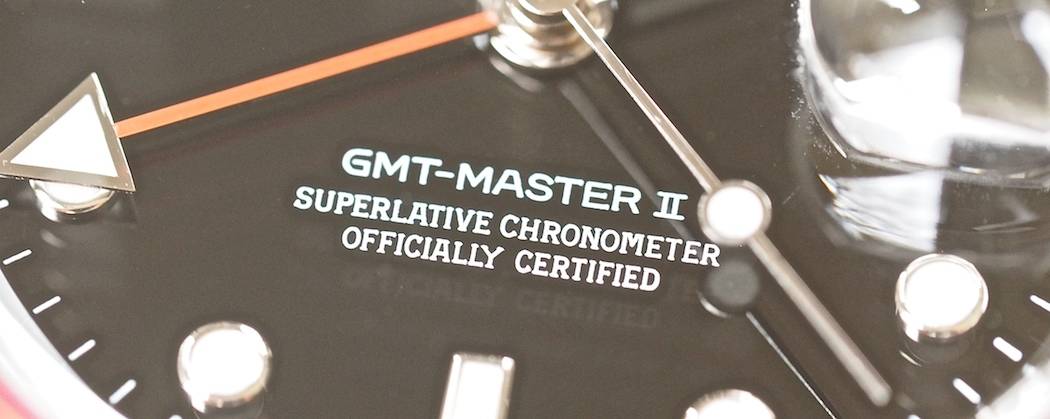
THe Rolex 16710 GMT-Master II dial font – that “II” was made in several variations and drives collectors nuts!
Thanks for taking a look at one of my favorite newer watches – the Rolex GMT-Master II 16710. It’s a nice alternative to a Submariner if you’d like a Rolex but want something a little less common. Also, I’d actually guess that the GMT’s functionality is more usable than that of the Sub’s – I think more of us travel than dive. Happy hunting and until next week…

